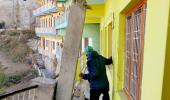
As the crisis worsens in Joshimath, with residents being relocated in the aftermath of rapid land subsidence, claims and counterclaims are flying thick and fast.
Two key infrastructure projects are being blamed for the havoc in Joshimath -- the NTPC Tapovan Vishnugad Hydro Electric Project and the Char Dham national highway project.
The Union ministry of power has come out in support of its wholly owned power generator NTPC, backing its claim that the hydropower project had no role in play in the land subsidence.
In a letter to the chief secretary, government of Uttarakhand, Union Power Secretary Alok Kumar said the land subsidence in Joshimath was a very old issue, dating back to 1976, and the construction of the 4x130 megawatt Tapovan Vishnugad project started only in 2006 by NTPC.
'The project includes the construction of a concrete barrage at Tapovan (15 km upstream of Joshimath town). The head race tunnel (HRT) of the project is not passing under Joshimath town. The tunnel is at a horizontal distance of around 1.1 km away from the outer boundary of Joshimath town and vertically around 1.1 km below the ground level,' Kumar's letter stated.
'Construction of the tunnel in this stretch has been done through a tunnel boring machine (TBM), which causes no disturbance to the surrounding rock mass,' Kumar added.
A committee constituted by the district magistrate Chamoli concluded in August 2010 that there was no ground evidence of any instability induced by HRT excavation using TBM, the power secretary pointed out.
'Construction of the tunnel on this stretch (at more than 1 km away from Joshimath town) has been completed in August 2011. Construction of the tunnel in rock mass at a depth of around 1 km causes no impact on the surface ground, including flora and fauna,' Kumar said in his letter.
'There are no signs of sinking around the tunnel alignment at the overground surface.'
With the ringing of the new year, all hell broke loose in Joshimath as houses developed massive fissures. This was followed by the subsidence of land in the hill town.
Joshimath is situated at 6,000 feet in the Chamoli district of Uttarakhand and is in seismically active Zone V -- a region with a high risk of earthquakes.
According to the seismic zoning map of the country, Zone V is seismically the most active region and approximately 11 per cent area of the country falls under this category.
In any landslide-prone location, construction activities like hydropower and highways make the location more unstable.
Kumar in his letter referenced the M C Mishra Committee and DM Chamoli Committee reports, suggesting several reasons for the crisis -- from subsurface seepage erosion by natural drainage to underground saturation resulting from poor sewerage.
Previous flood events aggravated the erosion along the left bank of the Alaknanda river, adversely affecting the stability of the slope on which Joshimath town is situated, the letter said.
According to a satellite-based report by the Indian Space Research Organisation, slow subsidence of up to 9 cm has been recorded in Joshimath town for seven months, between April and November 2022 and 5 cm in the past 12 days alone.
Joshimath is the gateway to various famous pilgrimage sites, including Badrinath and Hemkund Sahib.
At least 15,000 residents in the town are now being relocated. Several hotels are also being dismantled as part of the government's drive to stabilise the area.
Feature Presentation: Ashish Narsale/Rediff.com












 © 2025
© 2025